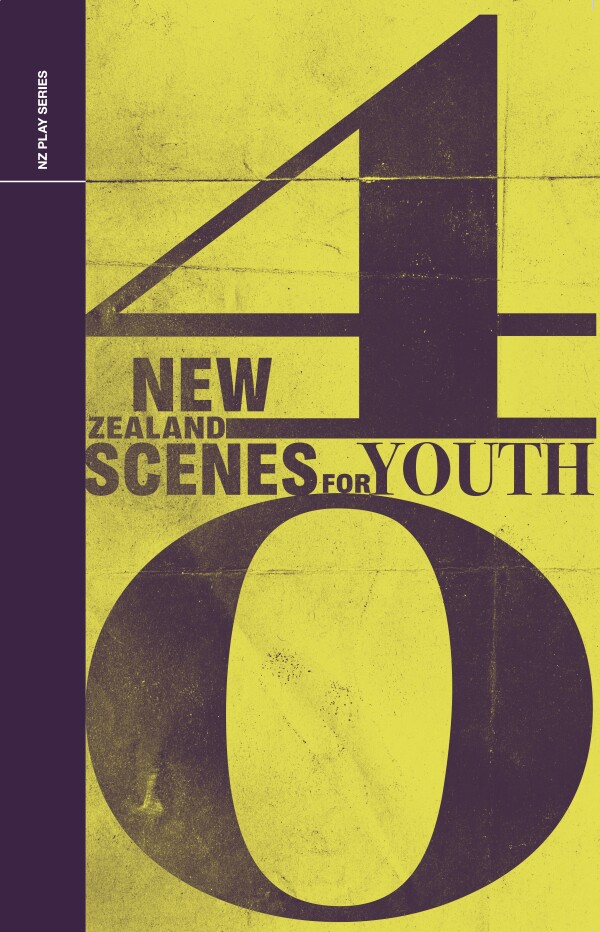40 NEW ZEALAND SCENES FOR YOUTH
Playmarket Online Bookshop, Global
01/01/2024 - 31/12/2024
Production Details
Edited by Shane Bosher
Coca-cops are marching on the resistance. Rūaumoko is stretching out, destroying cities. Qiu Ju must choose—love or family?
40 New Zealand Scenes for Youth is a comprehensive and contemporary toolkit for young performers. These scenes explore a broad range of genres and voices. The book is a showcase of deeply relatable narratives about community and connection.
Many of the scenes are from plays that have shaped theatre history in Aotearoa, such as The Pōhutukawa Tree by Bruce Mason, Makerita Urale’s Frangipani Perfume and Briar Grace-Smith’s Purapurawhetū.
Alongside these classics are scenes drawn from the best new writing for the stage. These include Katie Wolfe’s The Haka Party Incident, Inky Pinky Ponky by Leki Jackson-Bourke and Amanaki Prescott-Faletau, and Riding in Cars with (Mostly Straight) Boys by Sam Brooks.
Comprising a mix of established and emerging New Zealand playwrights, this collection is an invaluable tool for drama students, teachers and actors preparing for performance. It’s the perfect companion piece to 101 New Zealand Monologues for Youth.
Theatre , Book ,
An essential resource for young practitioners and anyone working with the youth demographic
Review by John Smythe 28th Jan 2024
Late last year Playmarket launched 40 New Zealand Scenes for Youth – an indispensable resource for Drama Schools, University Theatre Departments, Youth Theatre directors, high school Drama teachers, community theatre groups and anyone else seeking suitable plays for young players. In his Foreword, editor Shane Bosher describes the scenes a “suitable for actors aged thirteen to twenty-five years – for year 9s just starting out to intrepid drama school students looking for a meaty dramatic challenge.”
The 30th volume to be published in Playmarket’s impressive NZ Play Series, produced in collaboration with students of the Whitireia Publishing Programme, it also stands as a testament to the rich diversity of Aotearoa NZ’s playwrighting talent, spanning a full spectrum of cultures, genders, genres, settings, time frames, topics, themes and theatrical conventions: a tantalising tasting session; an absorbing buffet of brilliance; a kete of cultural taonga.
As Bosher explains in his Forword, the scenes are grouped in three sections: playful and joyous, aimed at younger performers; comedy; and drama, more suited to older actors. His notes on ‘Using this Book’ encourages “actors to be brave and thoughtful in their choices”, and explains that each scene is headlined with its genres and other relevant tags involving content.
Each scene specifies the Playmarket script page-range of the extract, includes a list of characters and their profiles, and is introduced with information about its provenance and the context for the excerpt that follows. I could write a whole other book about the style and content of each piece. Instead I’ll hyperlink the title to a Theatreview review or its Playmarket page.
Scenes from relatively recent works include Lysander’s Aunty by Ralph McCubbin Howell (a Covid casualty yet to premiere), The Haka Party Incident (by Katie Wolfe), Transmission (Stuart McKenzie), 8 Reasonable Demands (Joni Nelson), Astroman (Albert Belz), Lovin’ It (Jo Randerson), My Heart Goes Thadak Thadak (Ahi Karunaharan) and Boys (Eleanor Bishop).
They nestle in the kete with extracts from classics like The Pohutukawa Tree (Bruce Mason), Revenge of the Amazons (J Betts and W Shakespeare), Romeo and Tusi (Oscar Kightley and Erolia Ifopo), Dawn Raids (Oscar Kightley), Purapurawhetu (Briar Gace-Smith), Sons (Victor Rodger) and Frangipani Perfume (Makerita Urale).
I’m delighted to see scenes from Albert Belz’s Te Karakia, Gary Henderson’s Peninsula, Fiona Farrell’s Chook Chook, Oscar Kightley & Dave Armstrong’s Niu Sila, Vivienne Plumb’s The Cape, Jess Sayers’ Wings, Abby Howells’ Benedict Cumberbatch Must Die, Nigel Collins, Toby Leach and Damon Andrews’ Wheeler’s Luck, Paolo Rotondo and Rob Mokaraka’s Strange Resting Places, Nancy Brunning’s Hikoi, Helen Pearse-Otene’s Battalion, Eli Kent’s Thinning, Ralph McCubbin Howell’s Second Afterlife, Pip Hall’s Shudder, Sam Brooks’ Riding in Cars with (Mostly Straight) Boys, Nathan Joe’s Like Sex and Thomas Sainsbury’s Caustic.
Plays and playwrights I am less familiar with include *Leki Jackson-Bourke’s The Gangster’s Paradise and Inky Pinky Ponky co-written with ‘Amanaki Prescott-Faletau, Spilt Milk by Claire Ahuriri-Dunning and Yang/Young by Sherry Zhang and Nuanzhi Zheng (not yet listed by Playmarket).
*[I just tuned into an interview with Leki on RNZ’s Culture 101.]
There are more scenes I haven’t mentioned and the Appendix declares “we could have easily printed twice as many in this book”. It lists 48 more plays and playwrights “you could also check out”, grouped under Scripts for Younger Performers to Consider, Comedy, Drama, Underpinned by Historical Events, and Scripts for Older Performers to Consider along with a list of five playwrights whose One-Act and Ten-Minute Plays are also recommended.
The book ends with informative Author Biographies. My only gripe is they are not cross-referenced with the play titles for their 40 Scenes while the table of Contents lists only the play titles and not their writers. As with the Appendix, I feel users would be just as attracted to playwrights, if not more so, as to play titles when perusing the Contents.
40 New Zealand Scenes for Youth is an ideal companion to Playmarket’s 101 New Zealand Monologues for Youth (2019). Both volumes are essential resources for young practitioners and anyone working with the youth demographic.
Copyright © in the review belongs to the reviewer







Comments